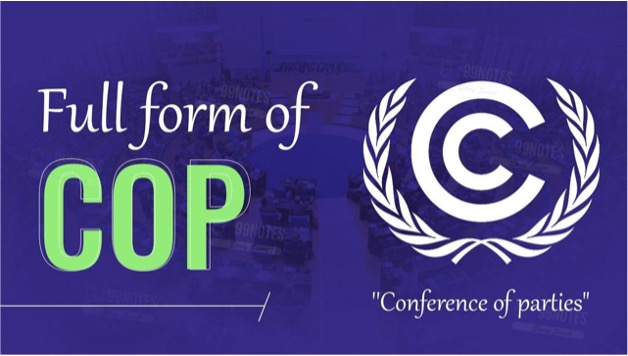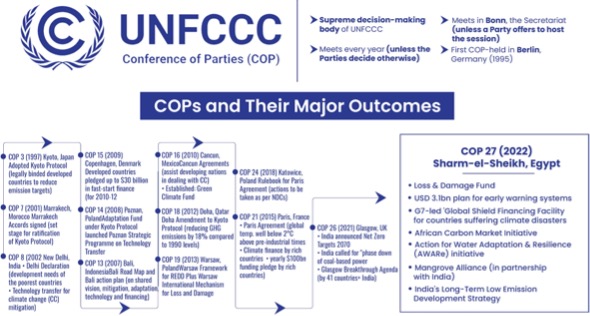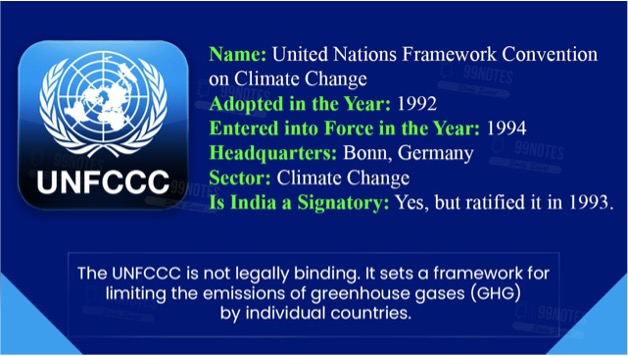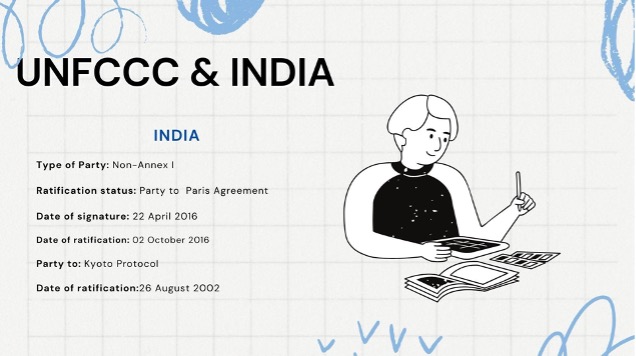COP Full Form: Conference of Parties | What is COP?

COP Full Form in Environment
The COP full Form in Environment is “Conference of Parties”. COP is the apex decision-making body of the United Nations Convention on Climate Change (UNFCCC). Every state that has ratified the convention is represented at the Conference of Parties (COP), where decisions regarding institutional and administrative management and arrangements, as well as the implementation of the convention and any other adopted legal instruments, are made in consensus.
Famous Full Form of COP
|
Acronym |
COP Full Form |
Context |
|
COP |
Conference of the Parties |
Environmental Agreements |
|
COP |
Chief of Police |
Law Enforcement |
|
COP |
Community Oriented Policing |
Policing Strategy |
|
COP |
Cost of Production |
Economics/Business |
|
COP |
Coefficient of Performance | Thermodynamics |
|
COP |
Cyclic Olefin Polymer |
Materials Science |
|
COP |
Change of Plea |
Legal System |
What is COP?
An international climate conference called COP is organised by the United Nations every year. The phrase “Conference of Parties,” or “COP,” refers to the nations that have ratified the United Nations Framework Convention on Climate Change (UNFCCC), an international agreement.
- As a part of their voluntary efforts to stop “dangerous anthropogenic interference with the climate system, “ parties to the treaty have promised to act.
- Every year, governments from various nations convene a conference where they discuss reports on progress and policy, establish interim objectives, and agree to share scientific and technological advancements that benefit the whole world. Scotland’s Glasgow hosted the conference the previous year.
The Conference of Parties of the Convention(COP), which has brought member nations together annually to discuss goals and responsibilities as well as identify and evaluate climate measures, has been held every year for the past thirty years, following the Rio Summit and the establishment of the United Nations Framework Convention on Climate Change (UNFCCC). The Paris Agreement, which mobilised worldwide collective actions to limit the global temperature increase to 1.5C over pre-industrial levels by 2100 and to adapt to the already occurring effects of climate change, was the result of the 21st session of the COP.
The highest decision-making body in any international convention is the COP. Every state that has ratified the Convention is represented at the Conference of Parties, where decisions regarding institutional and administrative arrangements, as well as implementation of the convention and any other adopted legal instruments, are made. Examining the national communications and emission inventories that the Parties have provided is one of the COP’s main responsibilities. The COP evaluates the results of the actions adopted by the Parties and the advancement of the ultimate goal of the Convention using this data.
Some of the responsibilities of COP:
-
- Examining the national communications and emission inventories that the parties have submitted is one of the COP’s main responsibilities.
-
- The COP evaluates the results of the action taken by the parties and the advancement of the ultimate goal of the convention using the data.
Unless otherwise decided by the parties, the COP convenes annually. Berlin, Germany, hosted the inaugural COP meeting in March 1995. Unless a party offers to host the meeting, the COP is held in Bonn, the secretariat’s home. Similar to how the five official UN regions – Africa, Asia, Latin America and the Caribbean, Central and Eastern Europe, Western Europe and others – swap turns to host the COP presidency. The location of the COP has a propensity to change among these groups as well.
Conference of Parties (COP) significant outcomes:

| CATEGORY OF PARTIES | MEANING |
| ANNEX 1 | Parties in Annex 1 are developed countries. There are a total of 43 parties. |
| ANNEX 2 | 24 countries of Annex 1 also come under Annex 2 countries. Countries in this category are expected to provide technical and financial assistance to the countries coming under developing countries |
| ANNEX B | Annex 1 countries are in this category, which have first or second-round Kyoto GHG emission targets. |
| LEAST DEVELOPED COUNTRIES (LDCs) | 47 member parties are in LDC. They are given special status under the treaty, taking into consideration their limitations |
| NON-ANNEX 1 | Parties that are not listed in Annex 1 come under the category of low-income developed countries. |
What is UNFCCC, and why is it so significant?

The United Nations Framework Convention on Climate Change is abbreviated as UNFCCC. It became operative on March 21, 1994. With 197 countries having approved it, its membership is expected to be nearly universal. The UNFCCC Conference of Parties (COP) is the collective name for the nations that have ratified the protocol.
UNFCCC acknowledge the existence of the problem:
For its time, this was impressive. Recall that there was less scientific evidence available in 1994, the year UNFCCC was established, than there is today. A key phrase of the 1987 Montreal Protocol, one of the most successful multilateral agreements ever, was appropriated by the UNFCCC: it required members to act in the best interest of human safety, even in the face of scientific uncertainty.
The ultimate goal of the convention is to keep Greenhouse gas concentration “at a level that would prevent dangerous anthropogenic interference with the climate system.” According to it, such a level should be achieved within a time frame sufficient to allow ecosystems to adapt naturally to climate change to ensure that food production is not threatened and to enable economic development to proceed sustainably.
Requires industrialized nations to set the example:
The theory goes that industrialized nations should make the greatest domestic efforts to reduce greenhouse gas emissions since they are the primary source of both past and present emissions. They are members of the Organisation for Economic Cooperation and Development (OECD)
Places responsibilities on the industrialized nations for setting the example:
The theory is that the industrialized nations should take the lead in reducing domestic emissions since they are primarily responsible for the majority of both past and present GHG emissions. These nations are members of OECD and are known as Annex 1 countries. Twelve nations from Central and Eastern Europe are among them; they have “economies in transition”. It was anticipated that Annex 1 countries would bring their emissions down to 1990 levels by the year 2000. To that end, many of them have moved decisively, and some have succeeded.
United Nations Framework Convention on Climate Change (UNFCCC) and INDIA

India ratified UNFCCC in 1993. In India, the nodal agency for the administration of UNFCCC is the Ministry of Environment, Forest and Climate Change.
Given that the nation is vulnerable to climate change related risks such as unpredictable monsoon and natural disasters including floods, droughts, landslides, etc. India has actively participated in efforts to mitigate the effects of climate change.
The 2006 National Environment Policy encourages social justice demands and ecological limits to be respected in addition to sustainable growth.
The National Action Plan on Climate Change was introduced by the Indian government in 2008.
India made a number of promises at COP 21 that must be fulfilled by 2023.
One pledge was to increase the amount of forest and tree cover by 2.5 to 3 billion tonnes of CO2 equivalent by 2030,creating an additional carbon sink.
India played a key role in the Coalition for Disaster Resilient Infrastructure’s establishment. India reaffirmed the importance of upholding the CBDR concept during the UN Climate talks in Poland, despite mounting worries that industrialized nations were attempting to undermine it.
UNFCCC COP’s Till date
List of UN Climate change conference :
| UNFCCC COP 1 | 1985 Berlin |
| UNFCCC COP 2 | 1996 Geneva |
| UNFCCC COP 3 | 1997 Kyoto |
| UNFCCC COP 4 | 1998 Buenos Aires |
| UNFCCC COP 5 | 1999 Bonn |
| UNFCCC COP 6 | 2001 The Hague |
| UNFCCC COP 7 | 2001 Marrakesh |
| UNFCCC COP 8 | 2002 New Delhi |
| UNFCCC COP 9 | 2003 Milan |
| UNFCCC COP 10 | 2004 Buenos Aires |
| UNFCCC COP 11 | 2005 Montreal |
| UNFCCC COP 12 | 2006 Nairobi |
| UNFCCC COP 13 | 2007 Bali |
| UNFCCC COP 14 | 2008 Poznan |
| UNFCCC COP 15 | 2009 Copenhagen |
| UNFCCC COP 16 | 2010 Cancun |
| UNFCCC COP 17 | 2011 Durban |
| UNFCCC COP 18 | 2012 Doha |
| UNFCCC COP 19 | 2013 Warsaw |
| UNFCCC COP 20 | 2014 Lima |
| UNFCCC COP 21 | 2015 Paris |
| UNFCCC COP 22 | 2016 Marrakesh |
| UNFCCC COP 23 | 2017 Bonn |
| UNFCCC COP 24 | 2018 Katowice |
| UNFCCC COP 25 | 2019 Madrid |
| UNFCCC COP 26 | Glasgow |
| UNFCCC COP 27 | Sharm el sheikh |
| UNFCCC COP 28 | UAE |
FAQs Related to COP Full Form
United Nations Conference of the Parties on Climate.
No, India has not hosted yet.
India is among the select few countries to have hosted the COP of all three Rio conventions on Climate Change.
What is the connection between Kyoto protocol and UNFCCC?
The Kyoto protocol is an international Agreement linked to UNFCCC. Kyoto sets binding targets for 37 industrialized countries and the European community for reducing greenhouse gas (GHG) emissions.
Other Related Links:
| Full Form | UNESCO Full form |
| SAARC full form | ASEAN Full form |
| IMF Full Form | CRZ Full Form |
| BRICS Full Form | UPSC Notes |
